Foot Deformities
Foot disorders can contribute to other problems in your ankles and knees. It could cause a misalignment of your legs and contribute to pain in your feet. If you feel that one of these foot disorders is affecting your life, it's best to speak with an experienced podiatrist such as Dr. John Scheland to learn your treatment options.
Types of Foot Deformities
What is a Bunion?
A bunion is a prominence or “bump” behind the great toe joint. The large bone behind the great toe is called the “first metatarsal” bone. For a variety of causes, this first metatarsal drifts away from the other foot bones. When this occurs, ligaments and tendons hold the great toe in place. This results in the great toe to drift towards the smaller toes causing deformity of the foot.
What Causes a Bunion to Form?
In many cases, bunions are inherited. Although bunions can be seen in children, most bunions form over time. The bones that form the arch of the foot become unstable and the bunion begins to form.
What are the Symptoms of Bunions?
The most apparent symptom of a bunion is the bony bump behind the great toe, especially when wearing shoes. Sometimes the joint becomes stiff and painful and can cause the small toes to curl and become deformed. In many cases, pain occurs in the pad of the foot behind the second toe especially when the second toe becomes deformed.
How is a Bunion Treated?
Treatments are separated into non-surgical (conservative) and surgical care. The goal of non-surgical treatment is to relieve pain whereas surgical treatment is directed at relieving pain by way of correction.
Conservative care starts with giving the foot plenty of room in a soft, wide shoe, preferably with heels less than 2” high. Bunion pads may help if your shoe still rubs too much. Toe spacers help with pain and rubbing of the great toe against the second toe, but it does not contribute to correcting the bunion or preventing bunions from getting worse. Orthotics are used to help support the architecture of the foot to slow bunion progression and help with pain during walking. If you can take them, anti-inflammatories help to manage pain as well.
Surgical care of bunions is directed toward correcting the deformity and by doing so, improving pain. Choosing the type of surgical correction is dependent on clinical and x-ray evaluation. There is no one procedure that fits all types of bunions. Generally, bunion procedures can be performed in a short period of time and patients go home shortly after the procedure. Use of a walking assistive device may be required to stay off of the corrected foot for a period of time.
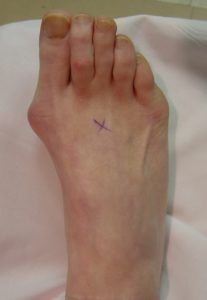
Bunion
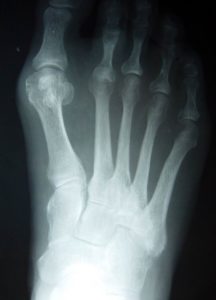
HAV X-Ray
Deformities of the lesser toes are common conditions. In the early stages, these toe deformities cause no pain. Over time, the deformity can worsen and become stiff causing pain and shoe fit difficulties. The most common deformities are hammertoe, mallet toe, and claw toe. While these deformities come in different forms they are generally referred to as hammertoes.
Why Toe Deformities Occur
The underlying root cause of toe deformities is an imbalance in the muscles that control how the toes lay. When the muscle on one side is stronger than the other, an imbalance occurs and the stronger muscle pulls the toe out of alignment.
There are several reasons why this could occur:
- Structure of the foot. Flatfoot, High arched feet called “Cavus foot”, Bunions and even trauma can lead to misalignment of the toes.
- Nerve damage. Progressive conditions like diabetes can cause the muscles in the feet to get weaker over time. This often leads to hammertoes or other deformities when the muscles are no longer strong enough to straighten out the toe.
- Shoes. Poor footwear can cause hammertoes to worsen. Poorly fitted shoes can squeeze the toes out of alignment. Prolonged use of poorly fitted shoes will allow one muscle group to gain a mechanical advantage leading to the misaligned toes to become fixed.
Treating Toe Deformities
When patient toes are still flexible, it may simply be beneficial to switch to shoes that are roomier and provide more comfort. Orthotics or pads can help to reposition an affected toe and relieve any accompanying pain and pressure. Stretches and strengthening exercises help in some cases. We can provide ones that may work well for you, but a popular exercise is to pick up a thin towel or marbles using just the toes.
Surgical intervention is usually reserved for patients who have either failed conservative care or pain due to fixed deformity. The choice of procedure depends on clinical and radiographic evaluation. Generally, procedures to correct hammertoe deformity can take a few minutes to up to an hour depending on the severity of deformity and how many toes need correction. Patients who undergo hammertoe procedures go home shortly after the procedure and may require a walking assistive device to limit foot usage after the procedure.
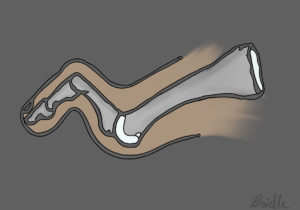
Hammertoe Drawing
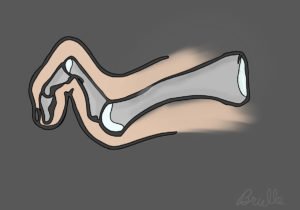
Clawtoe Drawing
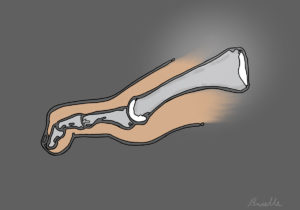
Mallettoe Drawing
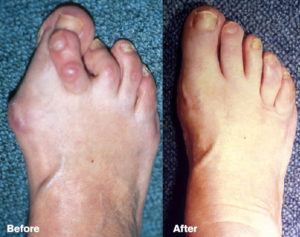
Hammertoe Before and After
Other Toe deformities
Macrodactyly
Macrodactyly is an overgrowth of a child’s toes or fingers. The toes grow abnormally large due to an overgrowth of the underlying bone and soft tissue. The condition is congenital and can be progressive.
Most of the time, only one foot is affected, but usually, more than one digit on that foot is involved. Macrodactyly is benign but is associated with other conditions and syndromes, such as neurofibromatosis, lipofibromatous hamartoma, vascular conditions, and tuberous sclerosis. Marcodactyly of the toes can cause pain due to improper shoe fit.
The cause of macrodactyly is unknown. The condition is not inherited, rather it is thought to be linked to disruptions in prenatal development.
Because macrodactyly produces visible deformity that can progressively worsen, most seek corrective surgical intervention.
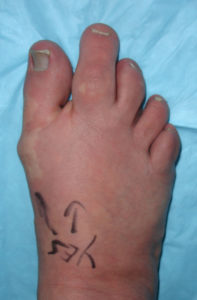
Macrodactyly
One of the most common foot disorders is flatfoot (pes planus), also known as fallen arches. This medical condition occurs when the arch of the foot Is flattened, allowing the entire sole of your foot to touch the floor when you stand up.
Usually a painless condition, flat feet can begin in childhood when the arch does not develop. Other causes include an injury to the foot or just stress to your feet as you age.
There are two types of flat feet:
Flexible Flatfoot
Most people with this condition never develop symptoms. They also usually have highly flexible and mobile joints in their feet and throughout their entire body. Causes of flexible flatfoot include hereditary, joint diseases such as rheumatoid arthritis, and nerve order dysfunction such as neuropathy.
If the pain or aching is mild, acetaminophen (Tylenol) or a non-steroidal anti-inflammatory drug (NSAID) such as aspirin or ibuprofen (Advil, Motrin, and others) may be effective.
For flexible flatfoot, no treatment may be necessary if there is no pain. However, corrective shoes may be prescribed to help relieve any discomfort you may feel. Surgery is usually only offered when non-surgical treatments are ineffective.
Rigid Flatfoot
Rigid flat feet are often the result of significant problems in the structure or alignment of the bones in the foot. Some common causes include:
- Congenital vertical talus — foot bones not aligned properly. Treatment includes serial casting where the foot is realigned gradually with each cast.
- Tarsal coalition — an inherited condition where two or more foot bones are fused. Depending on your age and severity of pain, non-surgical treatment such as shoe inserts or foot wrapping may be sufficient. More severe cases may require surgery.
- Lateral subtalar dislocation — also called acquired flatfoot, when a normal foot develops a dislocated talus bone in the foot. Treatment Includes relocation of the bone followed with a short leg cast may be all that is needed. Few patients require surgery.
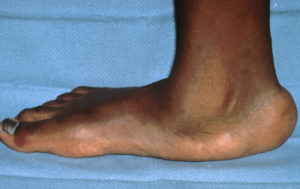
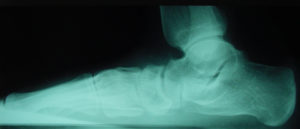
Note the loss of the arch height. Loss of arch height can damage joints over time.
High arched feet (cavus feet) are when the foot has an unusually high arch. When this condition exists, excessive weight is placed on the heel and the ball of the foot. Often cavus feet are caused by a neurological disorder such as:
- Polio
- Muscular dystrophy
- Stroke
- Cerebral palsy
- Spina bifida
- Charcot-Marie-Tooth disease
- Other medical conditions
- Hereditary
Non-surgical treatments include:
- Orthotic devices, such as shoe inserts.
- Shoe modification, such as high-top shoes or shoes with wider heels.
- A brace to keep the foot and ankle stable.
If the non-surgical treatment fails to reduce the pain adequately, then surgery might be indicated.
When a foot turns downward and inward, it is a condition known as clubfoot. Clubfoot can vary from flexible and mild pain to rigid and severe. Medically clubfoot is called congenital talipes equinovarus (CTEV) or talipes equinovarus (TEV)
The cause of clubfoot is not known. One possible cause is that it is inherited. Risk factors include family history and being born male.
The treatment of clubfoot may include moving the foot into the correct position then hold it in place with a cast. Treatment should start as early as possible; shortly after birth is ideal.
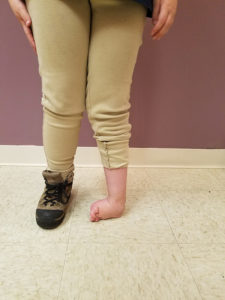
Neglected Club Foot - Before

Neglected Club Foot - Before
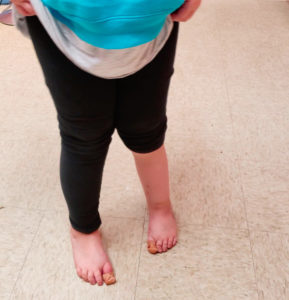
Neglected Club Foot - After
How NEPA Podiatry Can Help
If you experience pain or other severe issues to your feet, we're here to help. Contact NEPA Podiatry today to schedule an appointment.
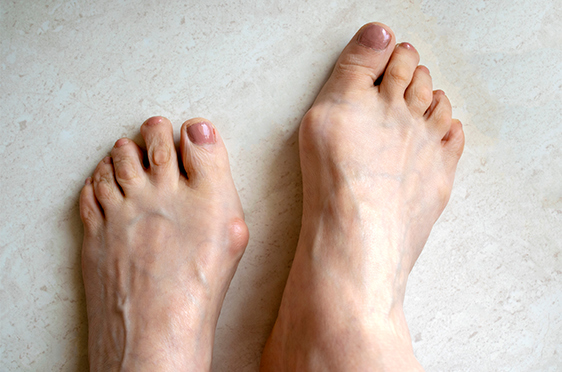
Disclaimer
This page is for information/educational purposes and does not constitute replacement for recommended diagnosis or treatments.
